1lumen selects and reviews products personally. We may earn affiliate commissions through our links, which help support our testing.
Fenix PD36 Tac review
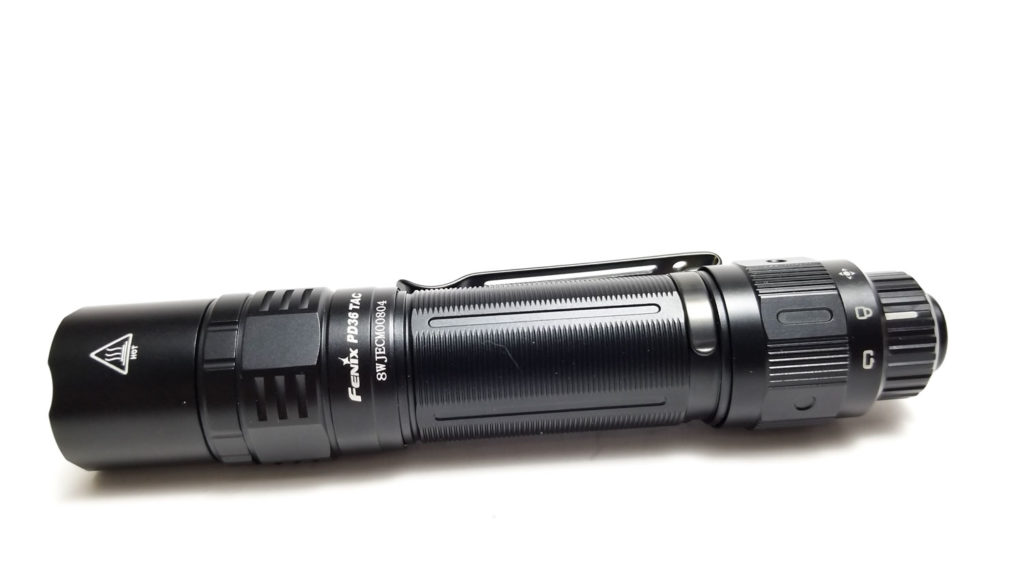
Fenix PD36 Tac specifications
| Brand/model | Fenix PD36 Tac |
|---|---|
| LED | Luminus SST70 |
| Lumens | 3,000 lm |
| Beam intensity | 18,700 cd |
| Battery config. | 1*21700 |
| Material | Aluminum |
| Modes | 8 |
| Blinkies | Strobe |
| Reflector | Smooth |
| Waterproof | IP68 |
| Review date | July 2021 |
Introduction:
When I think of ‘tactical’ and ‘flashlight’ in the same sentence, a couple of things come to mind. Besides guns n’ gloves, Fenix, Olight, and Nitecore. That’s sensible since these companies account for the bulk of the true tactical flashlight models floating around these days. Fenix has been in the business for a long time, and brings a great deal of know-how and experience to their products, and that’s good because the flashlight market is flooded with tactical light posers. If you’re in the market for a true, professional-grade tactical light, Fenix has you covered.
They even have special customized lights with Cerakoted with designs and colors, and will even gladly engrave your light for you with whatever custom design you like. I reviewed the refreshed TK16 V2.0 back in April and came away mighty impressed with the quality, performance, and overall tactical goodness. Fenix’s PD series are easily the most popular of the professional-use lights, and the PD36R earned a spot on our top tactical light list, so when I was asked to review a new PD36 I was all in. The new PD36 Tac brings some welcome upgrades from the original, including very interesting mode-switching and a major boost in output from a new emitter. Can you improve on near-perfection? I’ve been surprised before, so let’s see.
Package quality.
Packaging for the PD36 Tac is bog-standard Fenix, although this time the internal packaging is a little different from the Fenix TK16 v2 I reviewed. This is a retail package meant to be displayed in a store, so on the outside, you get the familiar eye-catching orange and black color scheme with contrasting glossy and matte graphics. I think Fenix may have been reading my mind a bit when they designed the inner packaging. The light still rides in a molded thin plastic carrier with the accessories hiding in the space underneath. However, this time the underside has a hinged bottom cover that holds the accessories in place so they don’t spill out all over when you pull out the carrier. This is nice because if I had a dollar for every time I had accessories fall out whenever opening a package, well I guess I could buy more flashlights. Here’s what you get:
- Fenix PD36 Tac flashlight
- 2 spare o-rings
- USB A to C charging cable
- Fenix ARB-L21-5000U button top 21700 battery (loaded in the light)
- User manual
- Warranty card
- Marketing insert
- Holster
This assortment is what I expect from Fenix and includes everything needed to get started. Fenix always includes a generous and easy-to-read user manual, and marketing inserts are nice, but I usually toss those. The battery was pre-installed with a plastic isolator to break the connection to prevent it from draining during transport, and it was charged to a nominal 3.7 volts, which is perfect for storage. No lanyard? No problem. There’s no lanyard hole anyway, and if you really wanted one, it can thread through the (attached) pocket clip.
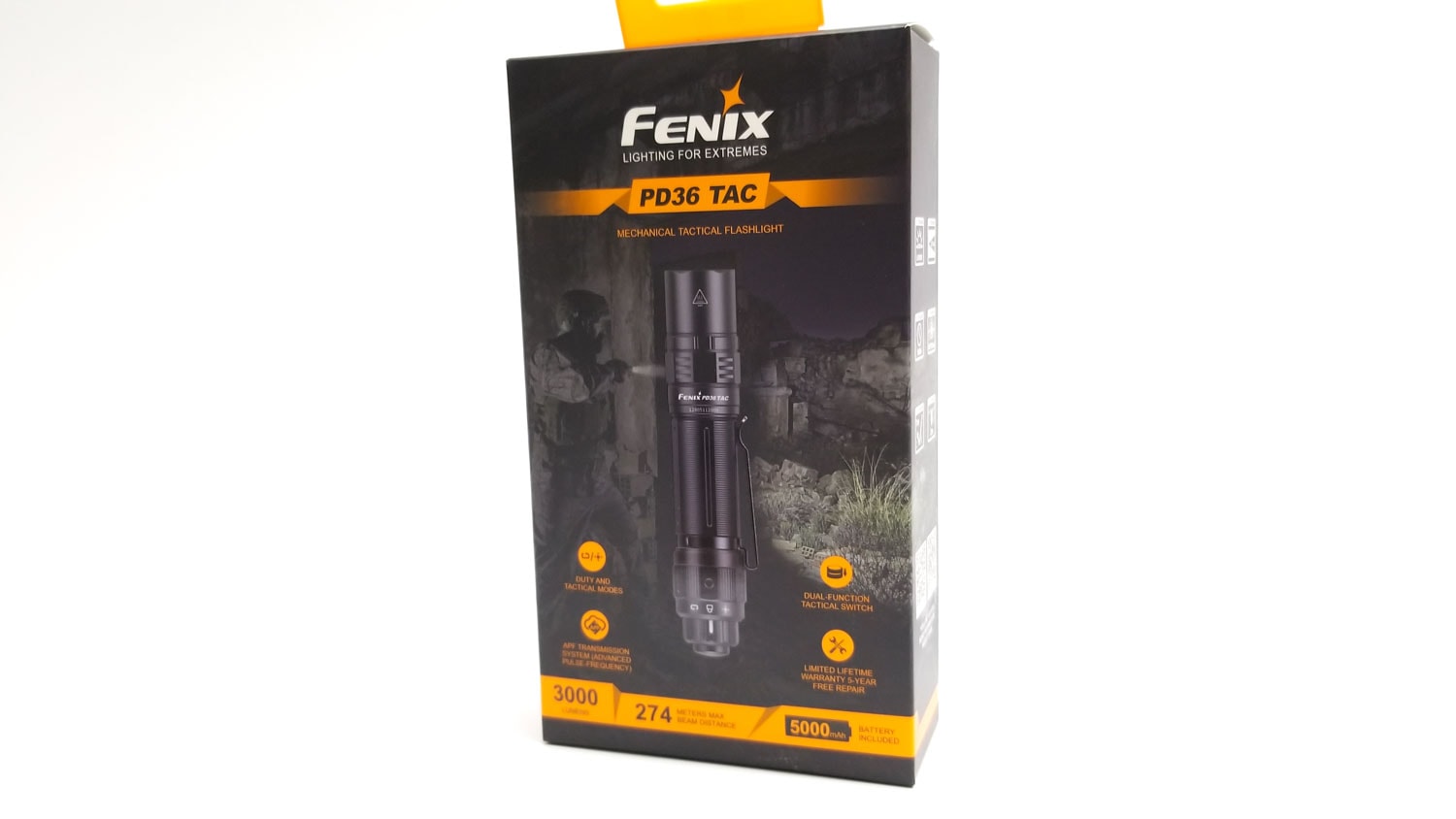
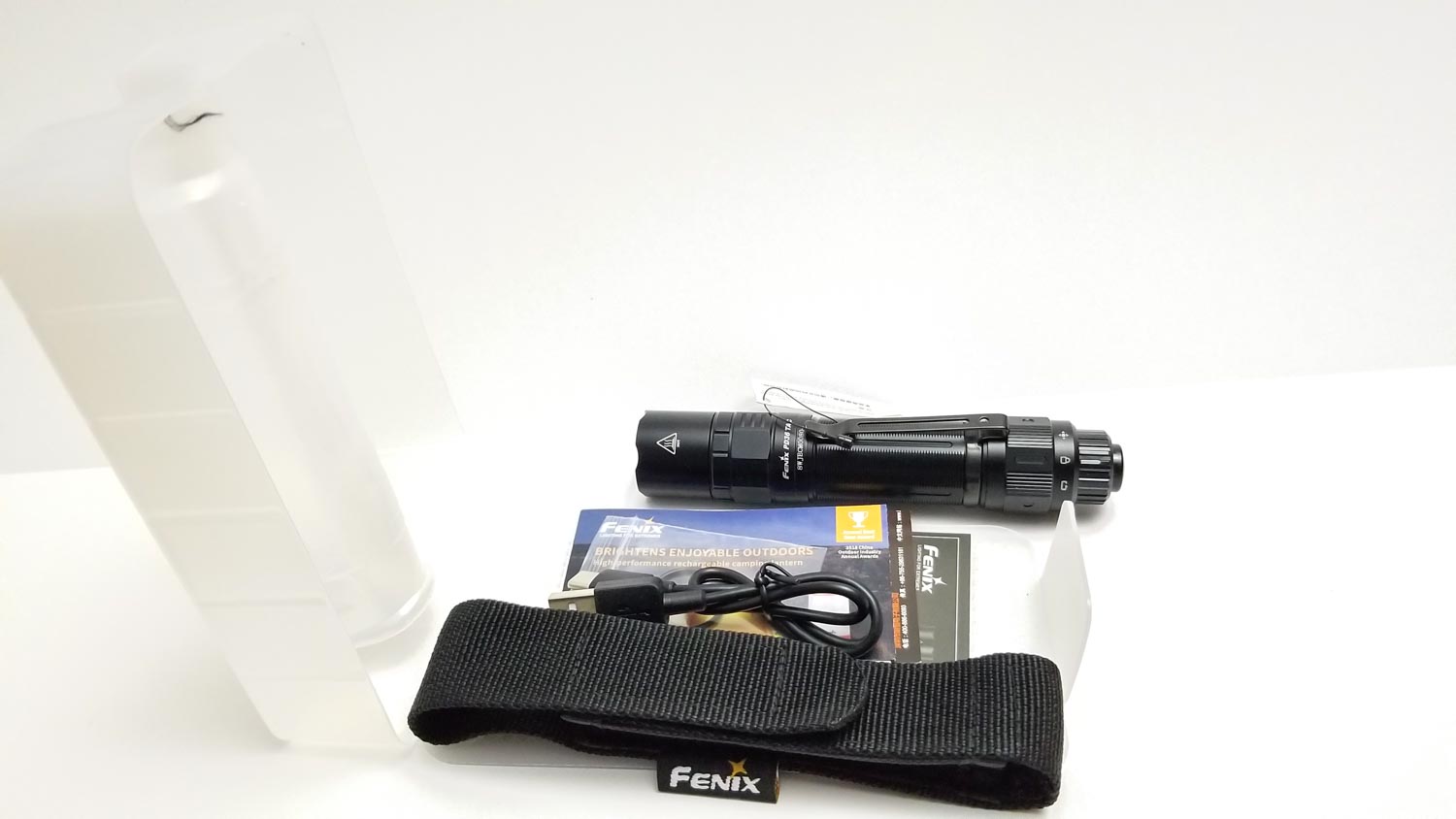
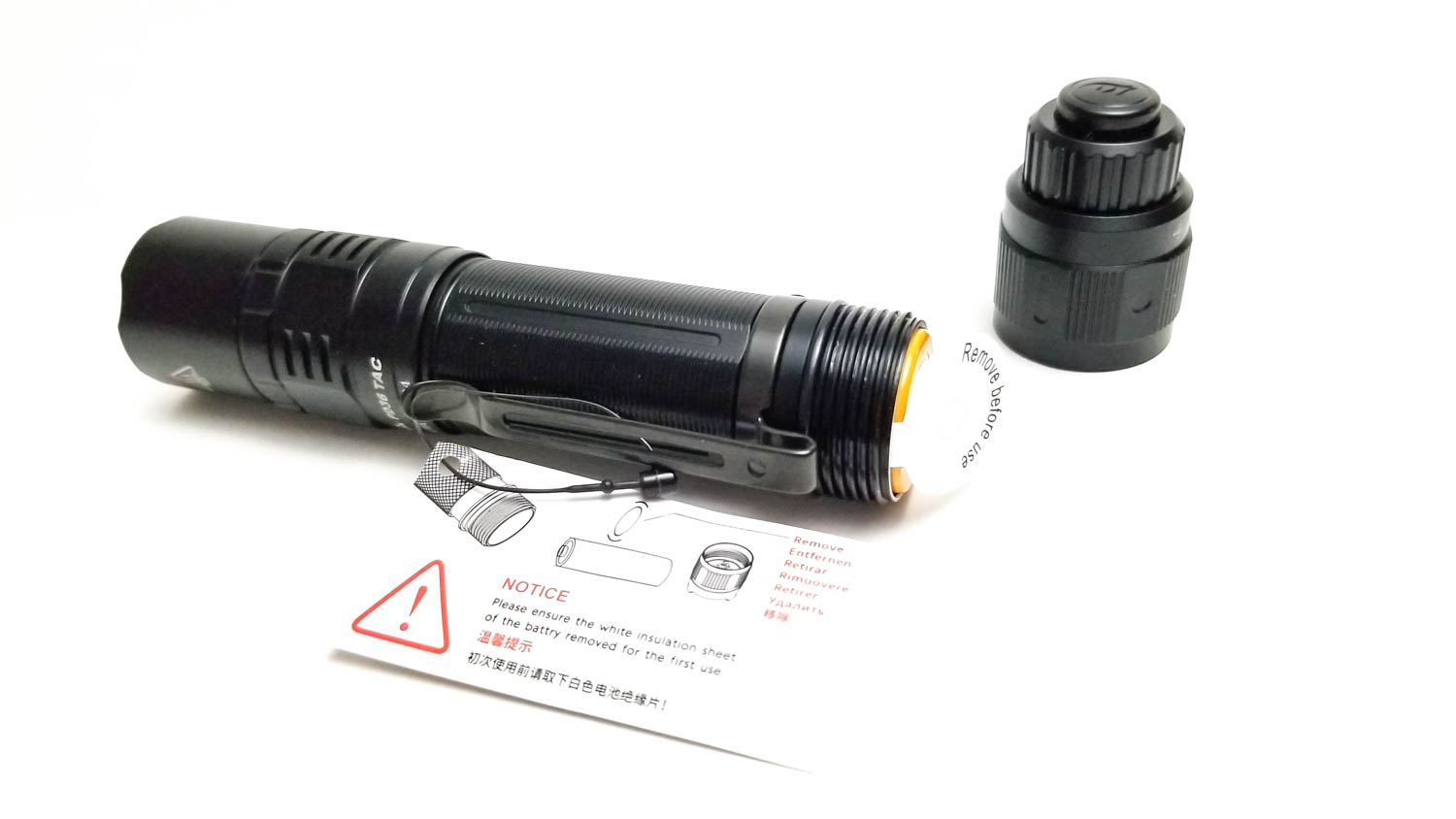
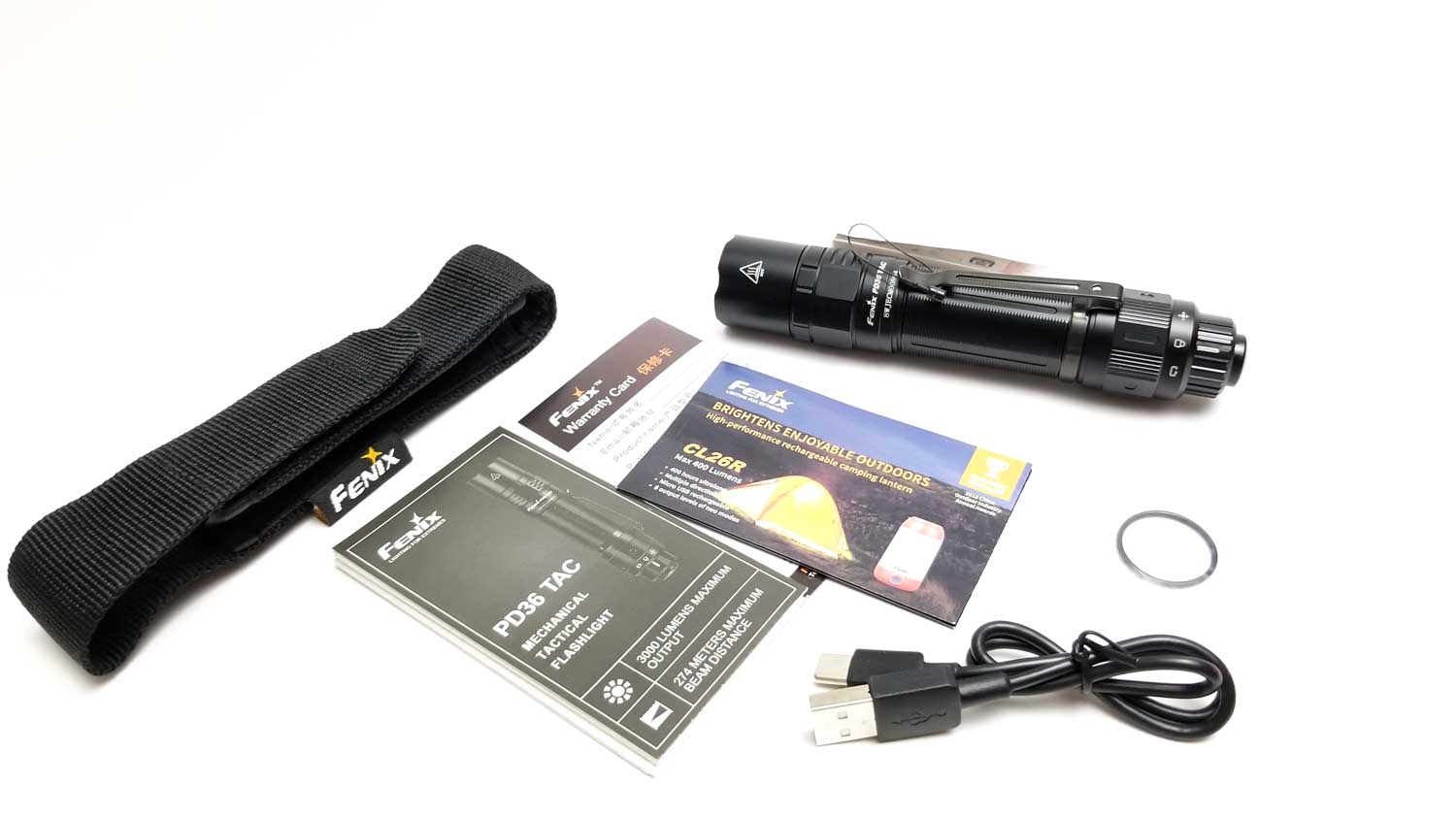
Flashlight in use
The PD series are professional-use lights with tactical feature sets and designed to be easy to use. The PD36 Tac isn’t exactly an upgraded PD36R or even a PD35 Tac, but an entirely new light.
Like the PD36R, this is a 21700 size light, so the handling is excellent since it fits a lot of different hand sizes. I had no issues with handling whatsoever with my large hands, and the controls are intuitive and easy to reach in all grip positions. There are anti-roll cuts in the head to keep it from becoming a rolling stone if the pocket clip is removed. Reaching the rear-mounted e-switch and rotary switch was easy also. It is a bit stiff though, and I think that’s due to the design. Fenix has indeed incorporated a very interesting switch into the PD36 Tac.
There’s a standard push button momentary switch that we’re all familiar with, but it sits inside a unique rotary switch carried over from the larger TK11 Tac light. The rotary switch has three positions: Duty Mode, Lockout, and Tactical Mode (more on these in the UI overview). The pushbutton switch is actually a dual-position forward switch, sort of like on Olight’s tactical lights can enable momentary or continuous operation based on how you press it. Lightly pressing/tapping gives momentary operation, but a firmer press until a tactile ‘click’ is felt enables continuous operation. Switching between the 3 modes is easy, and the rotary action is very solid and positive, with nice detented clicks at each step. The click action for the switch is firm, and even though the button is metal and didn’t have any ‘give’ like a rubber or silicone one, my thumb and fingers didn’t get fatigued and I had good control of the switch. I did notice the familiar Fenix logo is engraved on the switch. Details!
The body features Fenix’s familiar reeding machined in (small grooves/ridges) for grip, and they are quite effective. I never felt like the light was going AWOL on me. It has good heft without being heavy, nice balance, and just feels solid, like you’re holding a quality item. It doesn’t have a tactical ring, but I didn’t feel like that hindered the handling at all. The detachable pocket clip is also reversible, so you can carry the PD36 Tac bezel up or down. The holster is also nice and fully encloses the light. You can do bezel up or down carry with the hoster as well, so it’s very versatile.
The kit didn’t include a lanyard, and as much as I like having a lanyard, I think that’s fine since Fenix figured this is mainly going to be holster or pocket carried. If you wish to use one, you can thread it through a long cutout or hole on the pocket clip. The clip is sturdy and should hold onto whatever it’s clipped to.
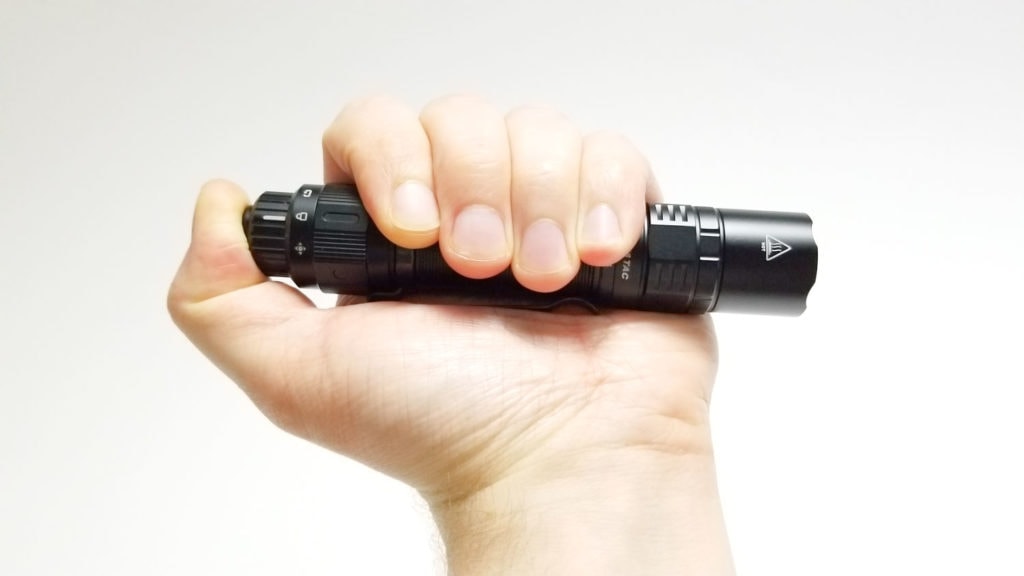
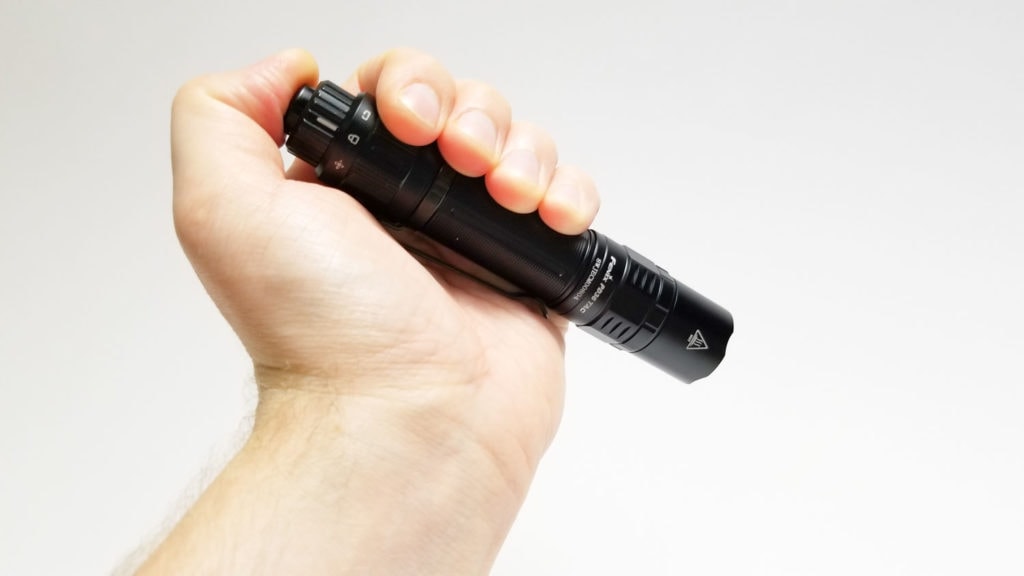
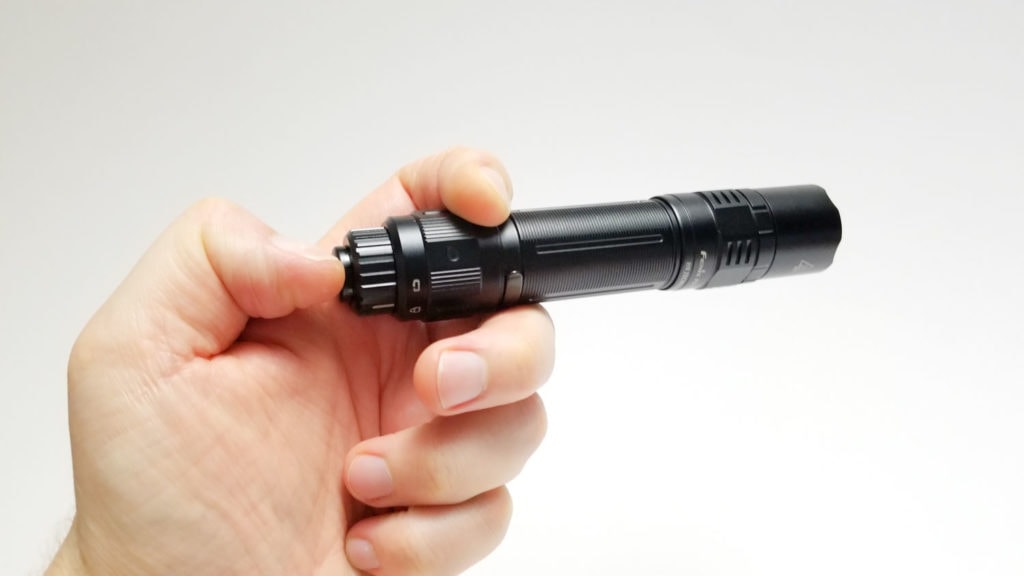
Build Quality, and Warranty
We’re all familiar with the saying, “You get what you pay for,” and although we’re getting some very nice, low-priced lights these days, when you step up to a professional-use flashlight, you’ll spend more money and usually get what you pay for. That said, the fit and finish on every Fenix I’ve handled is exemplary and commensurate for the asking price with no defects, machine or tool marks, and the Fenix PD36 Tac is no exception. The anodizing is type III HA hard anodizing and seems super durable. I didn’t see any significant wear after removing the pocket clip a few times or rotating it around in the mount, so I have no reservations the finish will hold up to use and abuse.
The light is constructed from A6061-T6 aircraft aluminum so it’s lightweight and tough. Aside from the removable pocket clip and tailcap, the light cannot be disassembled, which is fine since I don’t think it needs to be modded, and any defects over the life of the flashlight are covered under the excellent warranty.
Fenix’s warranty is pretty much on point with the other premium brands out there: 15 day no hassle free return, followed by a 5 year warranty for factory defects (1 year for rechargeable batteries) and a limited lifetime warranty (you are charged for parts needed for repairs). The warranty is extended 6 months for registering the light, so that’s nice.
The parts fit together perfectly with no gaps or uneven mating surfaces, and everything is super-solid. No rattles when shaken, so a pass on the Maracas test. The attention to detail is impeccable with sharp silkscreening throughout. Everything is chamfered and beveled to perfection for ultimate smoothness to prevent hang-ups when unholstering or re holstering.
For springs and threads, there’s a single gold-plated, short, thick spring on the tailcap and driver, and that’s important since this light is ready for weapon duty and dual springs are an important feature to prevent connection breaks or damage to the driver during recoil. The rear threads are precisely square cut, thick, and fully anodized for mechanical lockout if so desired. They were super-smooth and nicely lubricated. The tailcap is sealed with a single good sized o-ring, and obviously that’s enough for the IP68 rating I’m used to seeing for Fenix’s mainstream tac lights. The 6 is for solid particle ingress, and the 8 is for water resistance. For the record, IP68 means both parameters for ingress protection are tested by Fenix, not just one like you see in more budget lights. Testing of course costs money, so that’s part of the premium you’re paying when buying a light like this. It might not matter for most of us, but a professional who needs their light to work in a rainstorm or in an extremely dusty environment will appreciate that.
Like Fenix’s other tactical lights, the PD36 Tac can be complemented with a number of accessories including the AER-05 remote switch, ALG-00 Picatinny rail mount, ALB-01 bike mount, AB02 belt clip, and ALP-10 tactical duty holster.
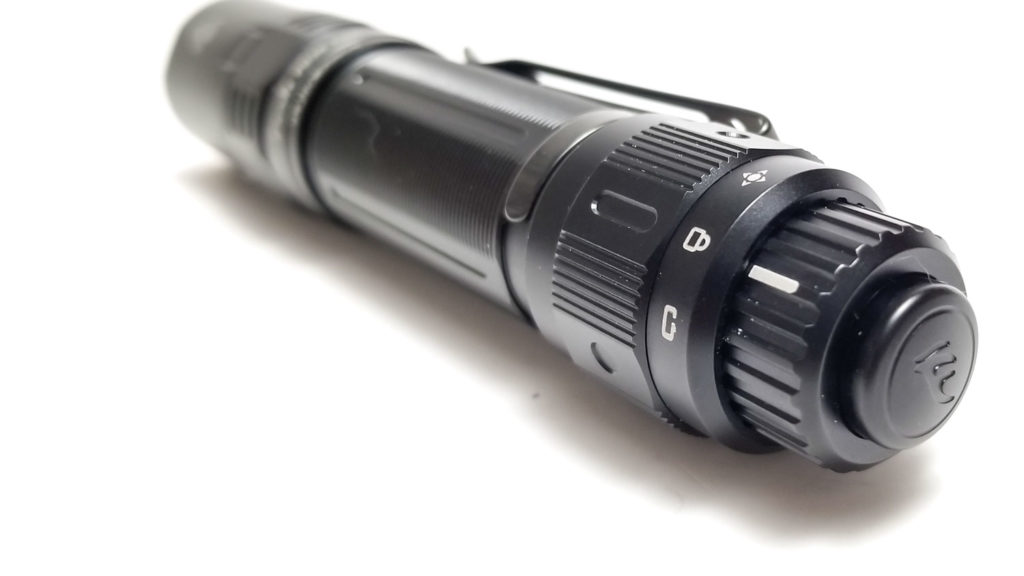
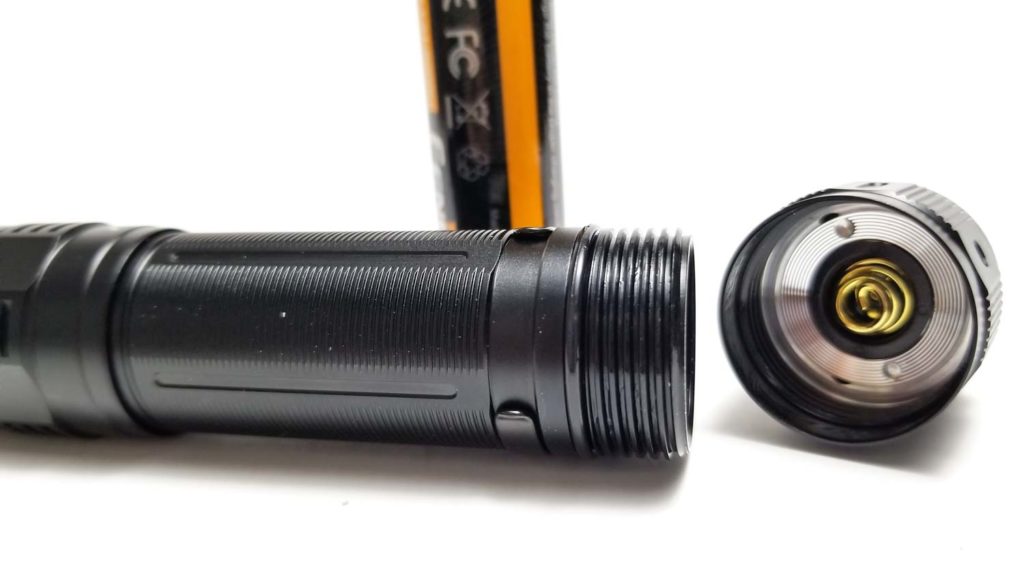
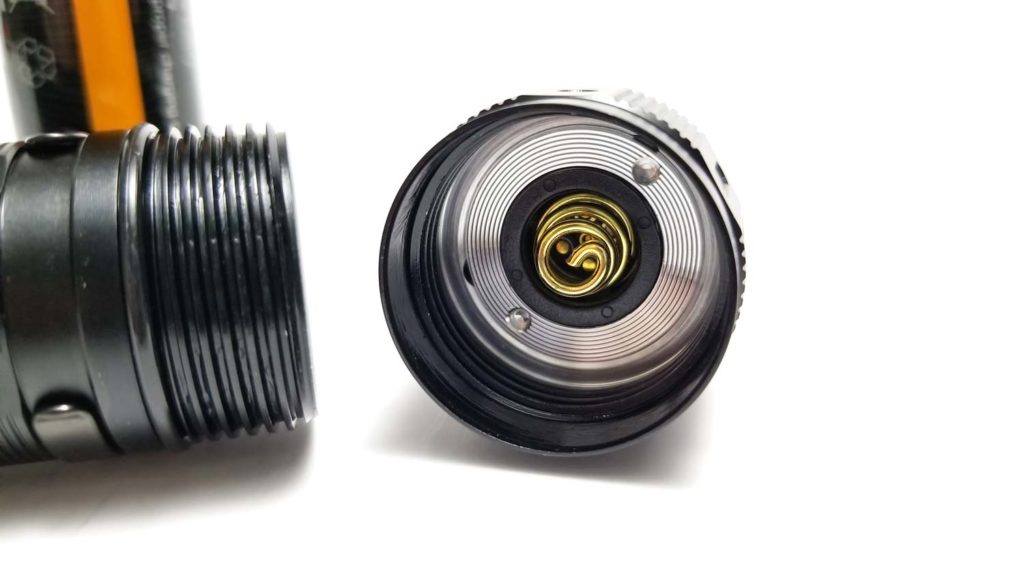

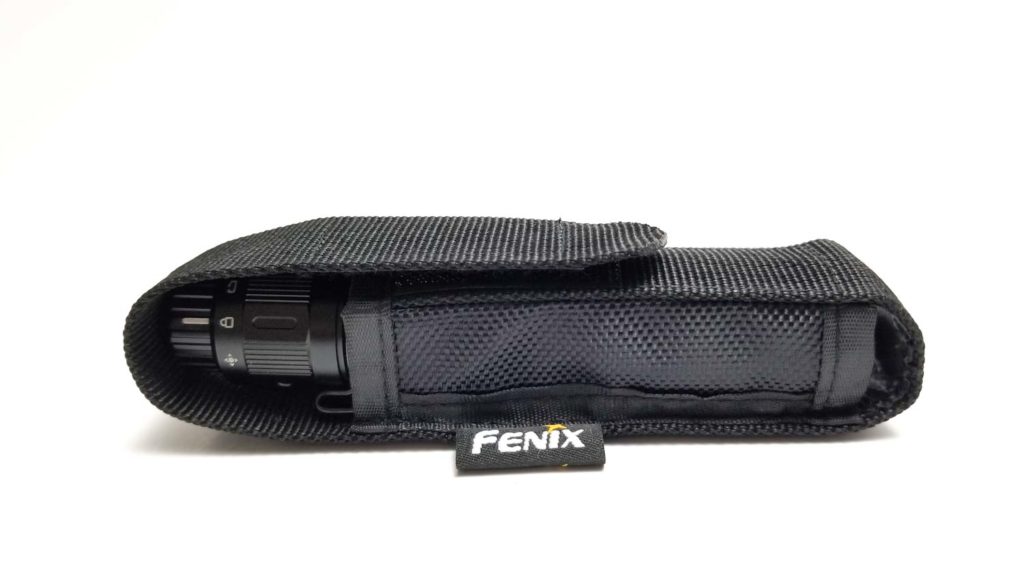
LED, Lens, Bezel, and Reflector
The Fenix PD36 Tac features an emitter I am pretty familiar with. The original PD36R featured the Luminus SST40, and the PD35 Tac had the Cree XP-L. However, the PD36 Tac steps up to the Luminus SST70. This is a 5050 footprint (5×5 mm) quad-die LED that runs off 6 or 12 volts. It’s the same size as a Cree XHP50.2, but the LES (light emitting surface) is about 55% smaller, so more light is concentrated into a smaller area, and that translates into more throw. The SST70 does throw better than my XHP50.2 lights, even though it gives up a few hundred Lumens. However, the SST70 doesn’t need to be driven as hard as the 3 volt 50.2 to get the same output.
The output is similar to the 3 volt XHP50.2, but you get a much improved beam free of corona and tint shift with more throw. This is one of my new favorite emitters and I’m glad to see Fenix using it in tactical lights. It is cool white (6500K) only though, and although not my favorite tint, it will be fine for 99% of folks who buy this light. Remember, they probably don’t care about high CRI or how above or below BBL the LED is. They just want it to light stuff up.
The bezel is integrated with the head and crenulated for self-defense purposes or checking if the light is on when placed bezel-down. The AR coated mineral glass lens is recessed about 3 mm behind the bezel, so it’s well protected from drops or scratches. The SST70 sits perfectly centered by a white centering ring in a flawless smooth aluminum reflector. The beam is about what I expected, with generous spill and a focused hotspot. It’s pretty sharp, but nowhere near XP-L HI or like the SFT-40-W in the Cyansky K3 I tested. There’s no tint shift, no corona, and this makes a nice and extremely versatile beam that’s great for looking for your lost Twinkie or car keys. It is subtly green at low power, but not too bad. I say less green than the TK16 V2.0, and way less green than the SST70s in the Imalent R30C. Maybe Fenix got some good bins with this production run?
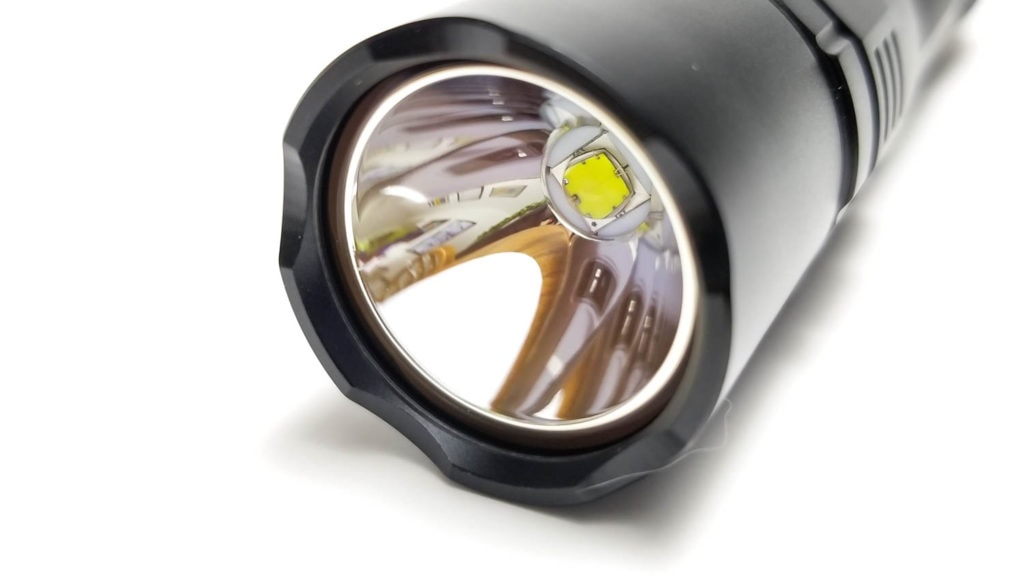

Dimensions and size comparison
- Length: 1 cm / 5.5 inches
- Head diameter: 2.65 cm / 1.04 inches
- Body diameter: 2.54 cm / 1 inch
Weight:
- With included 21700 battery: 164.4 grams / 5.79 oz.
- Without battery: 92.3 grams / 3.25 oz.
Tactical Flashlight size comparison
The PD36 Tac is pretty compact, smaller than a C8, and even a little smaller than the Fenix TK16 V2.0.
Left to right group 1: Olight Odin, Fenix TK16 V2.0, Fenix PD36 Tac, Acebeam L17.
Group 2 left to right: Thorfire C8, Fenix PD36 Tac, Cyansky K3.
Reflector shots left to right: Olight Odin, Fenix PD36 Tac, Fenix TK16 V2.0.
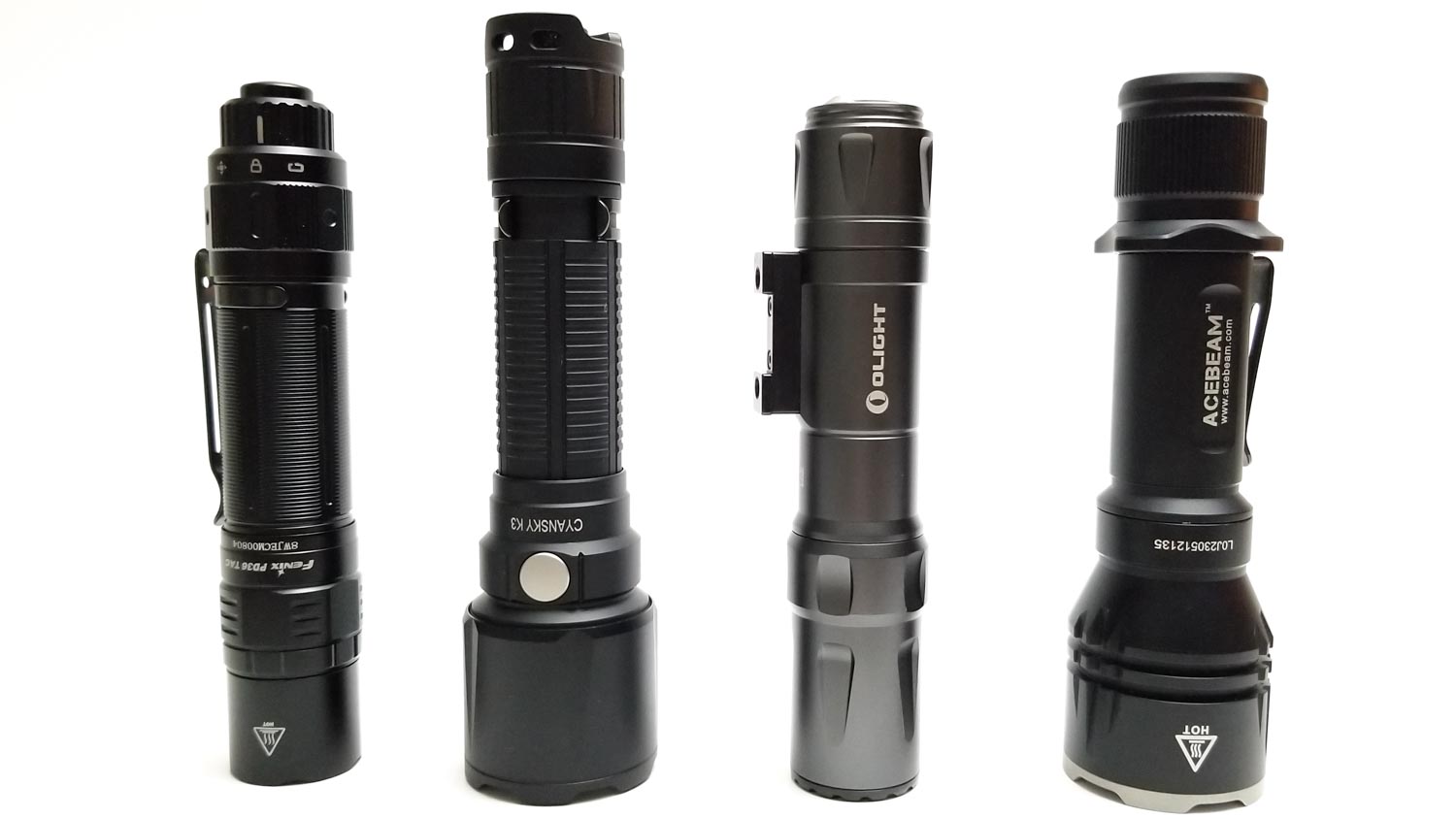
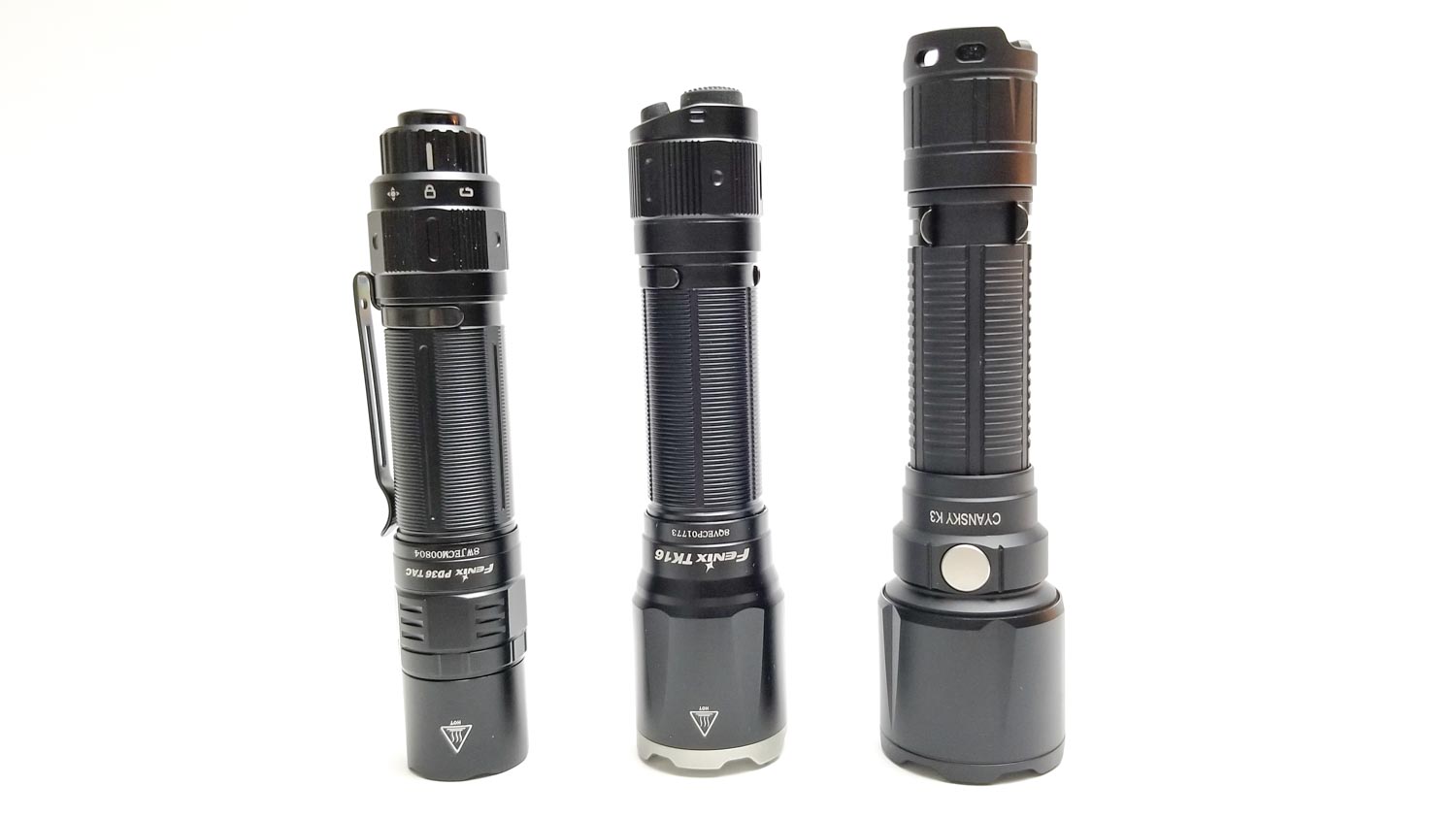
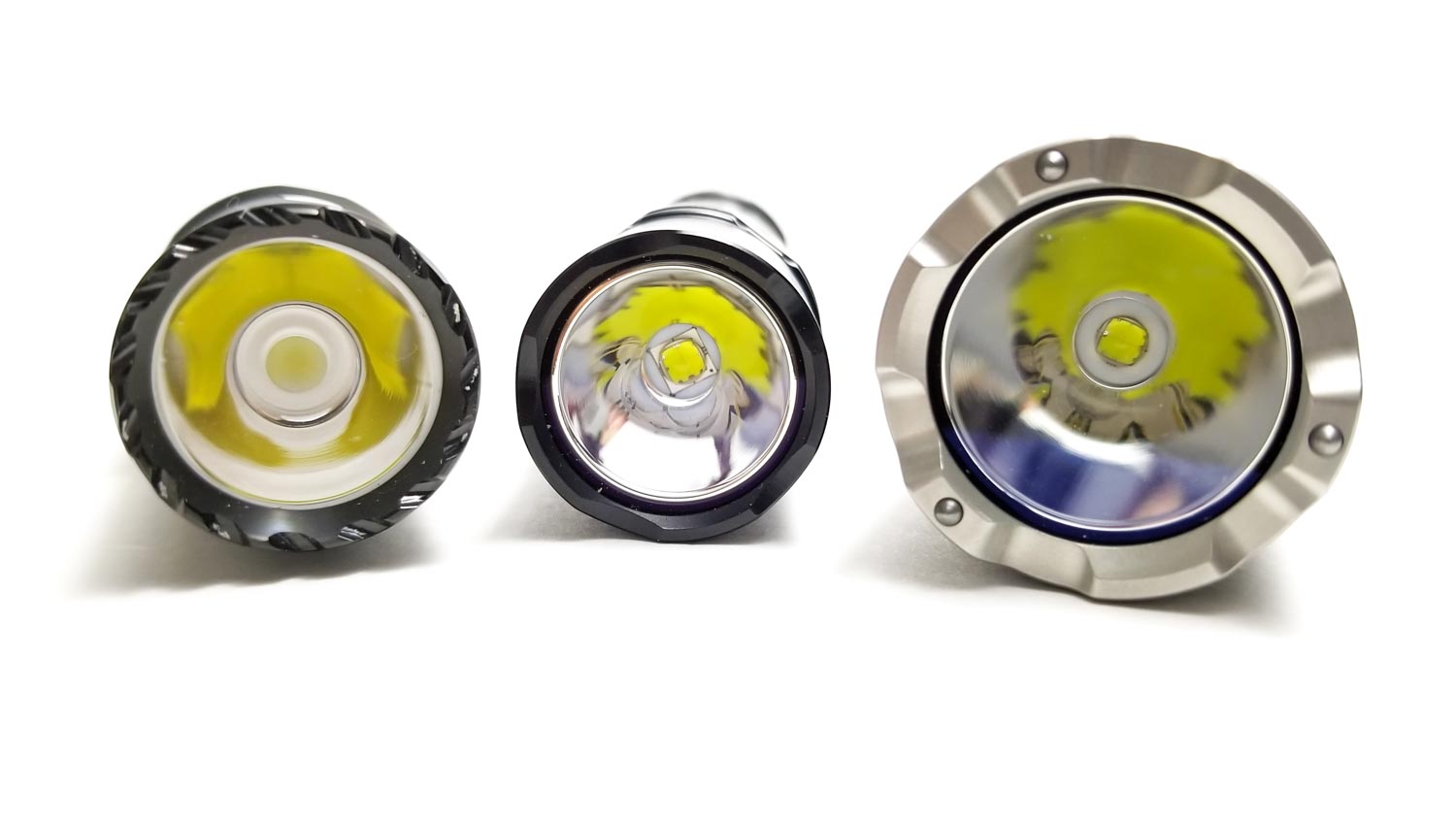
Driver & User Interface:
Fenix claims the PD36 Tac features a constant current driver for fully regulated output. That’s a pretty important feature for professional use lights, where constant output (no dimming as the battery drains) is necessary.
For the UI, you get 8 modes, but in keeping with the Tac designation, this is where it gets interesting. The light features a rotary switch and a traditional push button switch. The rotary switch has 3 positions: Tactical Mode, Lockout, and Duty Mode. Duty Mode features 5 separate modes (plus hidden Strobe), and Tactical Mode has a single mode that’s not quite Turbo bright, but still blinding, with the same hidden variable strobe activated by pressing and holding the button for more than 1 second.
Lockout is, well, just for lockout, although you can also manually lockout the light also. The push button switch is a forward switch, but works as a momentary switch or in continuous mode depending on how you press it. Sort of like Olight’s dual-stage switch, if you lightly tap the switch, it works in momentary mode, but a firmer press activates continuous mode. You get a very noticeable tactile click when activating the continuous mode also, which is nice because the switch doesn’t otherwise click at all. It works fine, and got better the more I used it. I found out that pressing and holding in Duty Mode also activates a variable strobe mode.
Modes: DUTY MODE: Eco, Low, Medium, High, Turbo. TACTICAL MODE: High, Strobe.
From OFF (Duty Mode):
- Press and hold: Continuous on. Pressing and holding for more than 1 second activates a variable strobe
- Single click: Changes modes Eco, Low, Medium, High, Turbo, Eco
- Double click: N/A
From OFF (Tactical Mode):
- Press and hold: Continuous on in High mode. Pressing and holding for more than 1 second activates a variable strobe
- Single click: Momentary on in High mode
- Double click: N/A
From ON (Duty Mode):
- Press and hold: Momentary/continuous on in last mode. Pressing and holding for more than 1 second activates strobe
- Single click: Change modes Eco, Low, Medium, High, Turbo
- Double click: N/A
From ON (Tactical Mode):
- Press and hold: Continuous on in High mode. Pressing and holding for more than 1 second activates a variable strobe
- Single click: Momentary on in High mode
- Double click: N/A
Mode memory:
- None
Low voltage warning:
- Yes. The output will drop to a preset level until it reaches Eco Mode where the light blinks 3 times every 5 minutes until the light turns off. Please note that this only works when using Fenix-branded batteries!
Strobe/blinkies
- Single variable strobe
Lock-out mode:
- Turn the rotary selector to Lockout Mode or unscrew the tailcap ⅛ turn to lock out.
PWM
- Yes. PWM is visible in the lower modes, but is a fast PWM and only visible with a camera. I did notice visible PWM when the LVP kicked in towards the end of the runtime tests though.
Additional info: I am generally not a fan of gimmicky UI’s or rotary switches, but I must say the combination of the rotary switch and push button switch is well executed here. True to tactical form, strobe can be called up in any mode. There is no mode memory either, which is also a tactical feature. The Lock mode on the rotary switch actually mechanically locks the button, so you can’t press it, and if that’s not enough, you can lock the light by unscrewing the tailcap slightly. How’s that for redundancy?
The mode spacing is just fine in Duty Mode, and I see why they didn’t use the full turbo output for Tactical mode. It’s still adequately bright/blinding at 2000 lumens (advertised), with the added benefit that it won’t get hot very fast and can sustain a decent output (don’t worry, I’ll test that). The modes are about perfect for a tactical use light, and I think any law enforcement officer, security guard, or other professional would appreciate the PD36 Tac’s range of modes and functions. The light also has Fenix’s version of ATR, set to a 60 C ceiling. This is a nice round number, and will be interesting to see how it works. If the TK16 V2.0 I tested is any indication, it will be pretty flawless.
Batteries & Charging
The Fenix PD36 Tac is designed around a single 21700 lithium-ion cell, and Fenix includes their familiar and excellent ARB-L21-5000U battery. This is a button top 5000 mAh cell with built-in USB type C charging, and features a protection circuit for LVP (Fenix does state that the LVP does not work unless you use the ARB-L21 battery). This is a non-proprietary battery, so any 71 to 75 mm long 21700 will work. A flat-top 21700 is too short, but a button top Epoch brand (re-wrapped Samsung 50G) 21700 I had worked fine (although there was a high-pitch ringing sound coming from the tailcap on Turbo).
Note that Fenix advises caution when using non-Fenix batteries, or batteries without a protection circuit because the light may over discharge the battery (the usual lithium-ion safety stuff) because the driver doesn’t have LVP built into it. Still, I like that you aren’t limited to using a manufacturer-specific cell, although most buyers probably won’t care.
The internal charging works pretty good, albeit a bit slow at 1.5 A on the charge current according to my USB meter. The battery is charged in about 3 hours if fully drained, and it is charged to 4.19 volts on the nose. If you’re impatient, you can charge it at up to 2.5 amps in an appropriate lithium ion charger.
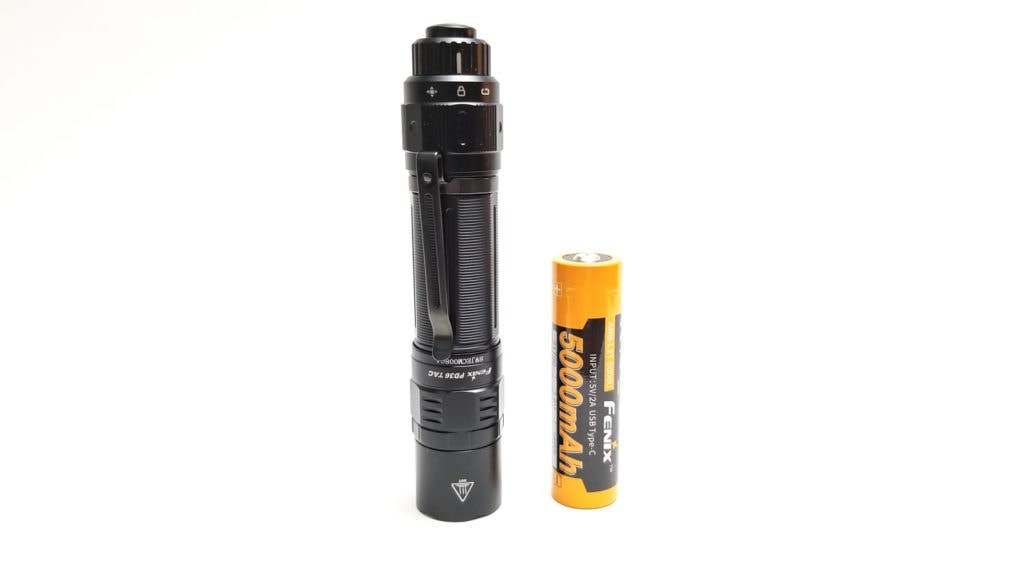
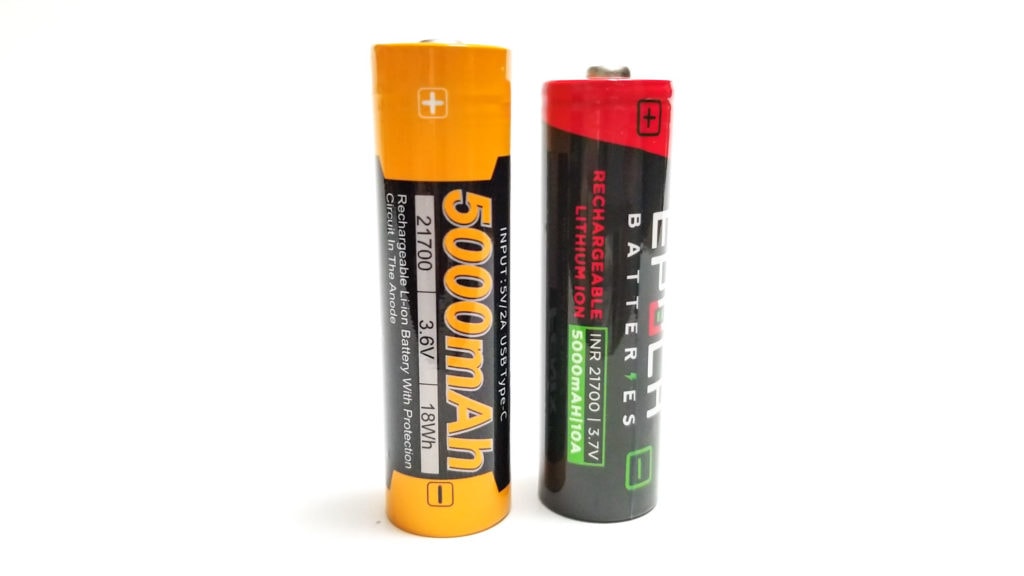
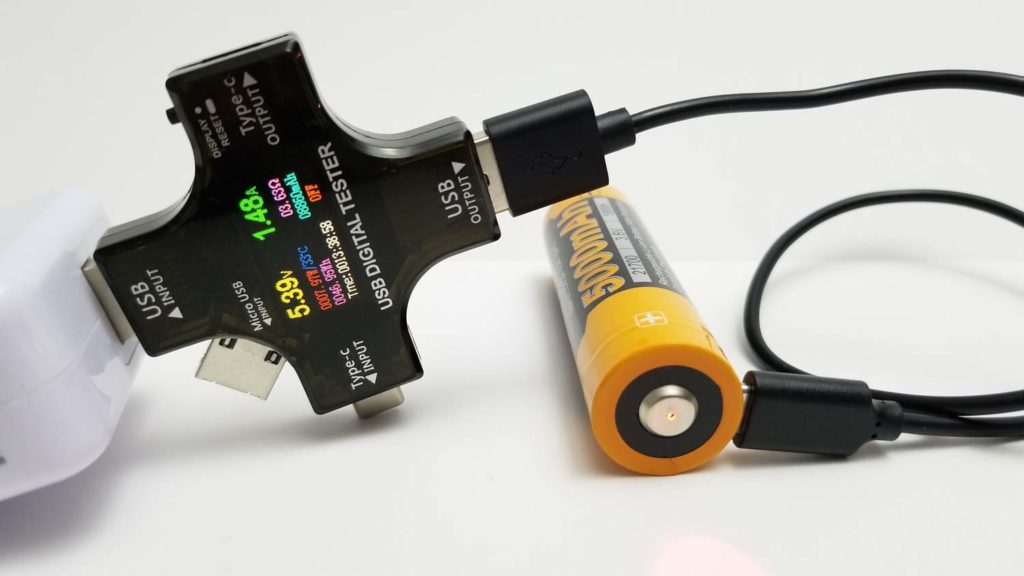
Performance
Fenix is an honest manufacturer when discussing output, and is one of the few who advertise runtime graphs in product descriptions.
Amp measurement
Due to the design of the tailcap and the current path, like with the Fenix TK16 V2.0, I was unable to measure the current at the tailcap. I was able to get a single measurement that was exactly like the TK16 V2.0 at 2 amps.
Parasitic drain:
0.22 mA. Fenix recommends charging the light if left unattended for 4 months to keep the battery in optimal condition.
Runtime graph
I conducted the runtime test using the 30 centimeter integrating sphere with the Digi-Sense 20250-00 data logging lux meter. I used the fully charged Fenix ARB-L21-5000U battery and tested Medium, High, Turbo, and Tactical mode High.
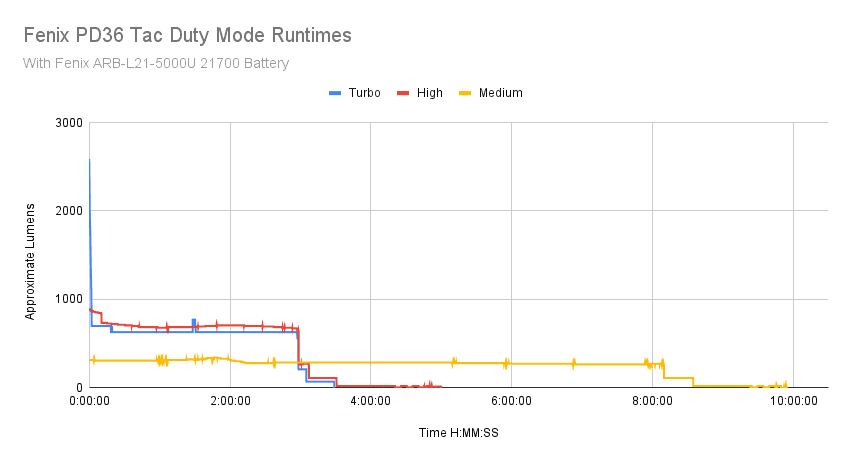
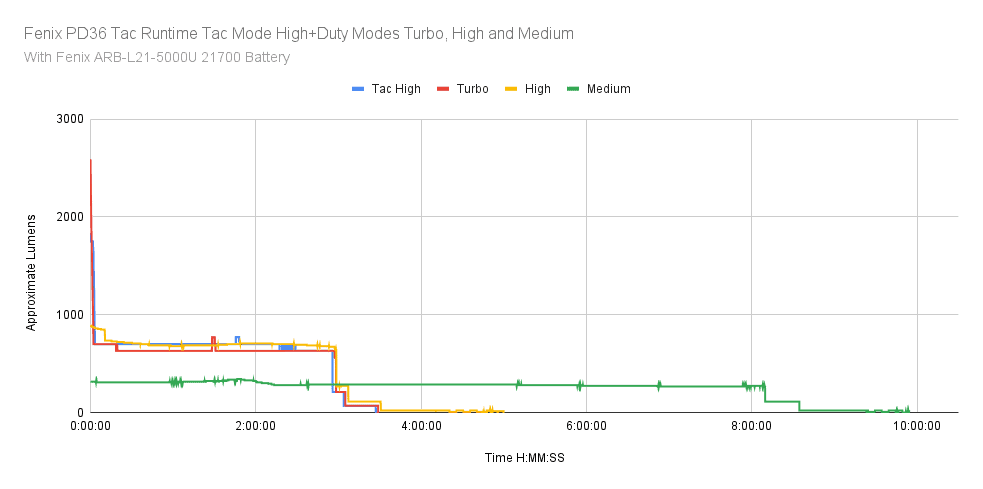

Turbo started under the advertised Lumens at 2590, and not surprising, started decreasing the output immediately. However, it still held over 2000 Lumens for 30 seconds, which in a small host is surprisingly good. However, the penalty is paid in heat: From ambient 26 C, it heated to 50.7 C in only 30 seconds, but the battery tube was still relatively cool at 44 C. At the 60 second mark, the output is still 1680 Lumens, which is more than the max advertised output of the PD36R’s 1600 Lumens. Impressive!
The output gradually decreases and levels off at the 2 minute mark to 700 Lumens where it stays for about 20 minutes, then drops a little to 630 Lumens where it sits for over an hour until the 1 hr. 28 min. mark where the output jumps to 770 Lumens as the temperature regulates the output. At 2 hrs. 58 minutes, the output takes a huge drop to 210 Lumens as the LVP starts to kick in. Towards the end of the runtime, we see the light drop the output to 70 Lumens until the light shuts off at the 3 hr. 29 minute mark. Fenix specs the runtime at 1 hr. 30 minutes, but at 1 hr. 30 minutes the output is still 630 Lumens? Hmmm.
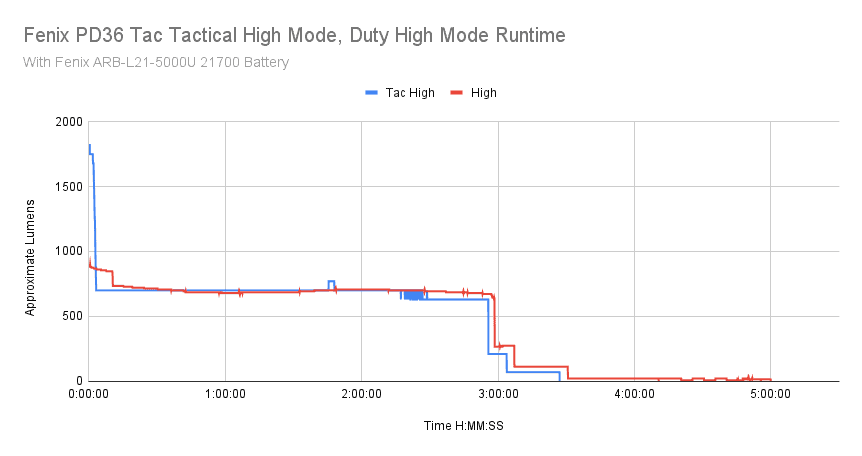
I tested the High mode in the Tactical setting on the rotary selector to see how it stacks up against Turbo in the Duty setting. Tactical High started at 1820 Lumens, and held that for 25 seconds and then dropped a bit to 1750 Lumens. By 30 seconds, the head is 44 C, which is very reasonable. The output stays above 1600 Lumens for over 2 minutes, which is impressive, and the output didn’t really drop until 2 minutes 55 seconds when it dropped below 1000 Lumens. From 3 minutes 10 seconds on, the output mirrored Turbo until the output dropped very low in similar fashion as LVP kicked in at 3 hours 3 minutes, and the light shut off at the 3 hour 27 minute mark. Pretty close to Turbo if you ask me. Fenix’s spec? 3 hours 10 minutes.
High and Medium in the Duty setting behaved similarly, with regulated output throughout the runtimes. High started at 889 Lumens and held that for about 10 seconds until stepping down slightly, but the impressive part is that the output stayed above 800 Lumens for over 10 minutes. Moreover, the output was over 700 Lumens for over 40 minutes, and the output varied between 650 Lumens and 700 Lumens for almost 3 hours. Very nice! The heating was negligible also, with the head getting up to 54 C by 1 hour, but the tube was cool enough to be comfortable to hold at 43 C (109 F). The output dropped to under 300 Lumens at the 2 hour 58 minute mark, and from there decreased to 21 Lumens by the 3 hr. 30 second mark. LVP started chiming after another hour, dropping the output to 7 Lumens before shutting down at the 4 hour 59 min mark. Fenix advertised the high runtime at 3 hour 10 minutes, so they must base that on the last step down before LVP pulls the output very low.
Medium started at 315 Lumens and held over 300 Lumens for over 2 hours, and held over 200 Lumens for the next 8 hours. There was a big step down at 8 hours 9 minutes, and LVP started blinking at the 9 hr. 24 minute mark, dropping the output to under 10 Lumens until the light shut off at the 9 hr. 54 minute mark. Heating was negligible here, as expected. Fenix specified 10 hours and 10 minutes for this runtime, so not far off.
Once again, we can make an argument for paying a premium price for a light like this. It’s the difference between a Mercedes S Class and a Toyota Corolla. They will both get you to work just fine, but the Mercedes coddles you with a refined ride, great handling and performance. The PD36 Tac has a nicely tuned driver, and the temperature regulation works awesome, with no rollercoaster behavior and runtimes close to advertised. I like the no-drama runtime graphs! The output is also fully regulated, something cheaper lights might not offer, so the output stays consistent throughout the runtime as the battery discharges. Unlike an FET driven or light with 7135 linear regulators, the light output didn’t decrease proportionally to the battery voltage. PWM is not noticeable in this light also, although at extremely low outputs before the LVP cut the output, I did notice some PWM. I don’t doubt Fenix’s claimed 18-hour for Low mode.
Lumen measurements (for each mode)
For the lumen tests, I used my home made 30 cm integrating sphere calibrated with a light of known output using the Digi-Sense 20250-00 data logging lux meter. I used the included fully charged 5000 mAh battery. Readings were taken at 30 seconds. I captured the turn on reading for turbo and high.
| Mode | Measured Lumens | Advertised |
|---|---|---|
| Eco | 25.2 | 30 |
| Low | 133 | 150 |
| Medium | 301 | 350 |
| High | 854 lm (861 at start) | 1000 |
| Turbo | 2079 lm (2590 at start) | 3000 lm |
| (Tactical Mode) High | 1780 lm (1820 at start) | 2000 lm |
One thing I’ve noticed is flashlights with lenses set deep inside the bezel seem to suffer from lower output figures. My guess is light is being blocked due to the aggressive bezel, but these are still very good numbers for a compact light, much higher than an SST40 could manage even in Tactical Mode, and blows it away in Turbo mode.
Throw numbers:
Throw was measured at 5 meters indoors using the Uni-t UT383S lux meter. I used the included Fenix ARB-L21-5000U battery for all tests. Readings were recorded at 30 seconds.
| Mode | Measured Throw | Advertised Throw |
|---|---|---|
| Eco | 150 cd, 24.49 m | 160 cd, 25 m |
| Low | 1125 cd, 67.08 m | 900 cd, 59 m |
| Medium | 2600 cd, 101.98 m | 2100 cd, 92 m |
| High | 6875 cd, 165.83 m | 6400 cd, 160 m |
| Turbo | 18,675 cd, 273.31 m | 18,700 cd, 274 m |
| (Tactical Mode) High | 16,100 cd, 253.77 m | 12,600 cd, 225 m |
My numbers are pretty close to Fenix and bang-on with Turbo. The output starts dropping at around the 25 second mark, so the 30 second figure for Turbo is on the low end comparatively. The SST70 is a pretty versatile emitter for throw and output.
Beamshots
I compared the PD36 Tac to the Fenix TK16 V2.0, and an Olight Odin.
- Outdoor shots: The fence is about 95 meters away.
- Indoors shots: The end of the long hallway is about 12 meters.
The PD36 Tac is a very versatile flashlight. The throw is pretty decent for a smallish flashlight, and the spill is more useful than with the OIight Odin. The TK16 V2.0 is easily the most versatile, but it’s also larger and heavier.




Disclaimer: This flashlight was sent to me for review at no cost by Fenixlighting. I have not been paid to review, nor have I been holding back on problems or defects.
Final Verdict
Pros
- Fantastic build quality, fit, and finish
- Great design
- Nicely implemented rotary selector and push button switch
- Consistent output
- Great beam
- Non-proprietary battery
Cons
- Switch felt a bit stiff
- Visible PWM at very low outputs near the end of the runtime tests
- SST70 is still a bit green at low output
- LVP is not built into the driver
Explanation on star ratings:
1: Avoid: my phone flashlight would be a better choice – 2: Poor: significant defect or issues, much better options available at the same price – 3: Average: some defects or issues – 4: Good: recommended (minor issues) – 5: Great: highly recommended

4.5 stars: ★★★★⋆
Fenix has once again proven they are near the top of the pack when it comes to professional-use lights. Whether tactical, EDC, or just a bonkers searchlight like the Fenix LR50R Gabriel reviewed a while ago, they know how to make a great flashlight. Dare I say that Fenix is getting a little too predictable? Well, maybe not in terms of innovation, but certainly other things like performance, fit, finish, and overall quality.
The PD36 Tac is a great example of product line scalability because Fenix already had the TK11 Tac featuring the rotary selector and forward switch, but Fenix knew the PD series was begging for a PD36-size Tac version. The PD36 Tac takes the already great PD36R and turns it up a few notches.
The massive performance boost and beam characteristics from the SST70 in a similarly-sized host with the added versatility of the rotary selector switch and UI are very welcome upgrades to the PD series. The fact you can use your own batteries is nice also. I can’t really think of anything major to pick on with the PD36 Tac other than it heats up fast on Turbo, and the switch takes some getting used to with the dual-stage functionality, and yes, the SST70 still has a case of the greenies at low output.
The fact LVP isn’t built into the driver is a bit odd considering that adding an LVP circuit to a driver isn’t that hard and on a light in this price range, I’d think it was included. That aside, this would be a great light for a law enforcement, security officer, or other professional who needs a dependable, high performance light that will turn on when they need it to. Make no mistake, I’m a hardcore budget light enthusiast to the core, but I can see why pro-grade lights are expensive and it shows in performance, attention to detail, warranty, and quality. 4.5 stars for the Fenix PD36 Tac.
Fenix PD36 Tac discount
Get 10% off every purchase at Fenix Lighting US, by using our exclusive 1lumen discount code: 1lumen10
1lumen selects and reviews products personally. We may earn affiliate commissions through our links, which help support our testing.